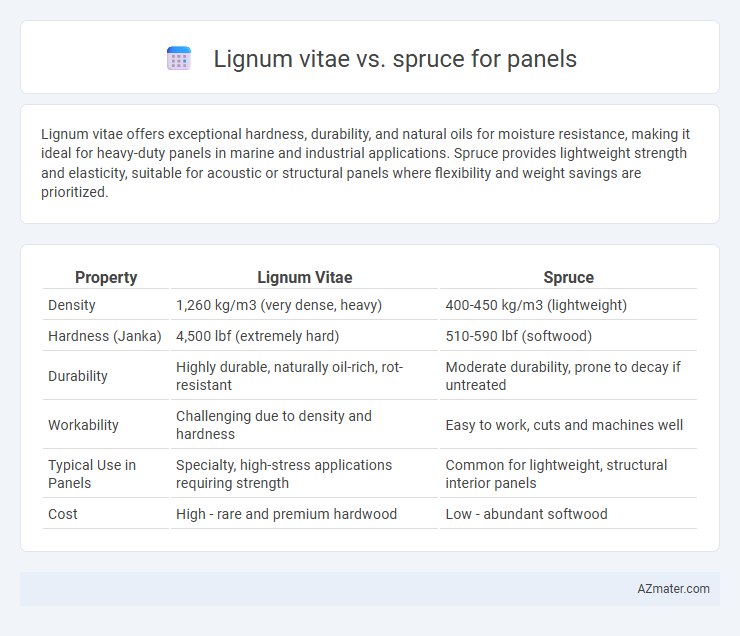Lignum vitae offers exceptional hardness, durability, and natural oils for moisture resistance, making it ideal for heavy-duty panels in marine and industrial applications. Spruce provides lightweight strength and elasticity, suitable for acoustic or structural panels where flexibility and weight savings are prioritized.
Table of Comparison
| Property | Lignum Vitae | Spruce |
|---|---|---|
| Density | 1,260 kg/m3 (very dense, heavy) | 400-450 kg/m3 (lightweight) |
| Hardness (Janka) | 4,500 lbf (extremely hard) | 510-590 lbf (softwood) |
| Durability | Highly durable, naturally oil-rich, rot-resistant | Moderate durability, prone to decay if untreated |
| Workability | Challenging due to density and hardness | Easy to work, cuts and machines well |
| Typical Use in Panels | Specialty, high-stress applications requiring strength | Common for lightweight, structural interior panels |
| Cost | High - rare and premium hardwood | Low - abundant softwood |
Introduction to Lignum Vitae and Spruce
Lignum vitae, known for its exceptional density and natural oils, offers extreme durability and resistance to wear, making it ideal for heavy-duty panels. Spruce, a lightweight softwood with a fine, uniform texture, provides excellent stiffness and workability, commonly used in construction and musical instruments. When choosing between Lignum vitae and Spruce for panel applications, factors such as strength, weight, and exposure to environmental conditions play critical roles.
Botanical Origins and Growth Regions
Lignum vitae, derived from Guaiacum officinale and Guaiacum sanctum trees, primarily thrives in the Caribbean and northern South America, known for its dense, oily hardwood ideal for durable panels. Spruce wood, sourced mainly from Picea abies and Picea glauca species, grows extensively across North America, Europe, and Asia, valued for its lightweight, straight-grained timber suitable for paneling. The contrasting botanical origins and growth regions deeply influence their physical properties and applications in woodworking and construction.
Physical Properties: Density and Hardness
Lignum vitae exhibits a high density ranging from 1.23 to 1.37 g/cm3, making it one of the densest and hardest woods, with a Janka hardness of approximately 4,500 lbf, ideal for heavy-duty panel applications requiring exceptional durability and wear resistance. In contrast, spruce has a much lower density around 0.35 to 0.45 g/cm3 and a Janka hardness near 510 lbf, offering a lightweight and softer option suitable for less demanding panel uses where ease of machining is prioritized. The significant difference in density and hardness directly impacts the performance, weight, and longevity of panels made from these woods.
Visual Characteristics and Grain Patterns
Lignum vitae exhibits a rich, dark brown color with subtle greenish hues and fine, interlocking grain patterns that provide a smooth, polished appearance ideal for decorative panels. In contrast, spruce features a light creamy color with straight, uniform grain patterns marked by occasional knots, giving a clean and natural aesthetic suitable for rustic or minimalist panel designs. The dense, oily texture of lignum vitae contributes to a lustrous finish, whereas spruce's softer texture allows for easier staining and paint absorption, affecting the overall visual appeal of the panel surface.
Durability and Longevity Comparison
Lignum vitae is renowned for its exceptional durability and natural resistance to decay, making it one of the hardest and longest-lasting hardwoods available for panels. Spruce, while popular for its lightweight and ease of workability, lacks the density and natural oils that contribute to Lignum vitae's superior longevity and resistance to environmental wear. For applications demanding maximum durability and lifespan, Lignum vitae significantly outperforms spruce in panel performance.
Workability and Machining Ease
Lignum vitae is a dense, oily hardwood known for its exceptional durability but presents challenges in workability due to its hardness and natural oils, which can dull tools quickly and require sharp, robust machining equipment. Spruce, in contrast, is a softwood with a light, straight grain that offers superior ease of machining and workability, making it suitable for panel applications requiring smooth shaping and fast processing. For panel manufacturing, Spruce's lower density and better machinability significantly reduce production time and tool wear compared to Lignum vitae.
Acoustic Qualities for Panel Use
Lignum vitae exhibits superior acoustic damping and natural resonance qualities, making it ideal for panels requiring sound absorption and vibration reduction. Spruce features a lighter density and exceptional stiffness-to-weight ratio, promoting clear sound projection and brightness, commonly preferred in musical instrument panels. For panel applications prioritizing acoustic performance, Lignum vitae excels in noise control, whereas Spruce enhances sound clarity and tonal quality.
Environmental Impact and Sustainability
Lignum vitae, known for its extreme density and natural oils, is highly durable but faces sustainability challenges due to slow growth rates and limited availability, leading to concerns over overharvesting and habitat loss. Spruce, commonly used in panel production, grows rapidly and is widely cultivated in managed forests, offering a more renewable and lower-impact option with reduced carbon footprint. When comparing environmental impacts, spruce panels present a more sustainable choice, supported by certifications like FSC, ensuring responsible forest management and replenishment.
Cost and Availability Analysis
Lignum vitae is significantly more expensive and scarce compared to spruce, primarily due to its slow growth rate and high density, making it a premium choice for panels. Spruce offers cost-effectiveness and abundant availability, especially in North America and Europe, favored for its balance of strength and lightweight properties. For large-scale panel production, spruce is economically viable and easier to source, while Lignum vitae is reserved for specialized applications requiring exceptional durability.
Best Applications: Choosing the Right Wood for Your Panel
Lignum vitae offers exceptional density and natural oils, making it ideal for high-wear applications like flooring or workbench surfaces where durability and resistance to moisture are crucial. Spruce is lightweight and features a straight grain, making it the preferred choice for decorative panels, acoustic panels, and interior wall coverings where ease of machining and a smooth finish are priorities. For best results, select Lignum vitae when strength and longevity are essential, and opt for spruce when weight and aesthetics are more important.

Infographic: Lignum vitae vs Spruce for Panel
 azmater.com
azmater.com